As soon as he had completed the singing of this verse, the Mother brought food to him. Guru Namasivaya ate it, resumed his journey, and soon reached another famous pilgrimage centre, Vriddhachalam. He had a bath in the River Manimuttar, had darshan of Lord Siva and Parvati in the form of Lord Pazhamalainathar and the Goddess Periyanayaki as they were being taken in procession through the streets of the town.
The River Manimuttar in spate, with the Vriddhachalam Temple in the background
He composed a verse there that first praised Siva and Parvati in their local forms, and then asked Siva to facilitate his union with his Guru, Guhai Namasivaya:
Supreme Siva, my Lord!
You who reside at Vriddhachalam,
You who share Your body with the Old Lady of the Mountain,
You of the luxuriant lotus feet,
unite me with the golden feet of Om Namasivaya,
the king among Gurus,
who resides on everlasting Annamalai. (Siva Kshetra Kovai, v. 6)
At some point during his stay there, he made an appeal to Periyanayaki, asking in his usual way for her to provide him with food:
Elderly Lady, You who are known as Periyanayaki,
abounding in goodness!
Elderly Lady, You who ever abide on the left side of Lord Siva!
Elderly Lady, You whose body is dark blue all over!
Elderly Lady of the mountain!
Elderly Lady, You who remain motionless!
I beg You, bring me rice!
Periyanayaki, the local name of the Goddess, is traditionally depicted as an old woman. As soon as he completed the verse, the Mother appeared as an elderly woman with a walking stick and said to Guru Namasivaya, ‘What is this, my son? Is it good to sing of me with your tongue, repeatedly calling me “Elderly Lady”? Can an old woman walk? Can she fetch water? Can she bring you food?’
Guru Namasivaya responded by saying, ‘Mother, at Balakasi [young Kasi] you are Balambika [young Ambika]. This is Vriddhakasi [old Kasi]. Here you are Periyanayaki [old woman]. Your Lord is also Pazhamalainathar [the ancient mountain Lord]. That is why I sang of you in that way.’
The Mother replied, ‘That may be so, but now sing of me as a young woman’.
Guru Namasivaya responded by saying, ‘If I do, I will be singing of two different Mothers’.
‘If that is so, then let it be,’ answered Periyanayaki. ‘But sing of me as a young person.’
Guru Namasivaya then composed another verse:
You who dwell at Vriddhachalam
girded by the River Manimuttar,
You at whose feet devotees fall in praise!
You who dwell at Lord Siva’s left side!
You whose ever-youthful breasts
are adorned by a string of beautiful pearls!
I beg you, bring me rice!
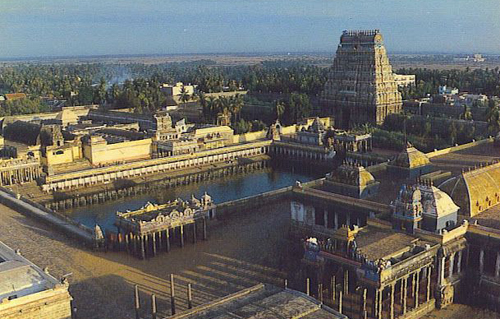
As he was concluding the verse, Mother, in the form of Balambika [the young form of Parvati], brought food to him. Sri Kumaradevar Sastrakkovai contains nine verses that were sung by Guru Namasivaya at Vriddhachalam. It is possible that he sang many verses at each of the places he visited and that the biographer whose text I am using merely used the verses that mentioned food. After eating the food that had been brought to him, he continued his walk and eventually reached the town of Bhuvanagiri. From this place his final destination, Chidambaram, could be seen in the distance.When Guru Namasivaya first sighted the four gopurams of the Chidambaram Temple from Bhuvanagiri, he spontaneously composed a verse that expressed the great joy the sight of them had brought to him:
At the mere sight of these four gopurams
all my sins have vanished
like cotton drifting into a flame.
O Lord of Tillai’s Hall,
whose ruddy feet are girt with tinkling anklets,
what indeed will be the benefit
for those who cast their eyes upon Your feet!
Tillai, the ancient name for Chidambaram, is the Tamil name for a tree (excoecaria agallocha) which is common in that area. It also refers to the forest of Tillai trees that originally surrounded the town. The ‘Lord of Tillai’s Hall’ is Nataraja, the presiding deity at Chidambaram.

Guru Namasivaya was singing this song as he reached Chidambaram. On his arrival he took a bath in the Siva Ganga Tank in the main temple, after which he composed yet another song in praise of the Holy Mother:
Karma will flee at the mere sight
of the tirumanjanam of Mother Sivakami,
praised with full voice by those who possess rich Tamil.
In the instant they gather this water in their palms
and consume it, [devotees’] karma will be plundered.
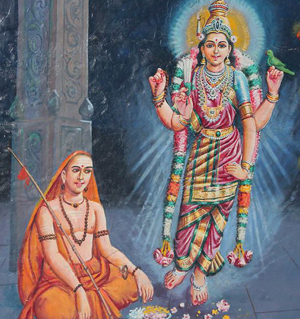
The word tirumanjanam denotes both the liquid mixture that has been used to worship and bathe a temple image and the act of bathing it. Guhai Namasivaya had great reverence for this tirumanjanam and wrote several verses praising it (Tirumanjana Venba vv. 419-28).
Sivakami, meaning ‘The lady who desires or who is desired by Siva’, is the name of the female deity in the Chidambaram Temple. She is the silent witness to Lord Nataraja’s dance in the inner sanctum.
Guru Namasivaya completed his bath in the Siva Ganga Tank and walked into the temple, expecting to have the darshan of Lord Nataraja in the inner shrine. Instead, in that place, the Lord gave him darshan in the form of Guhai Namasivaya, who was then still living on Arunachala. This unexpected manifestation prompted Guru Namasivaya to compose a verse in praise of Siva:
Lord of the Golden Hall! Supreme mystery!
You who grant to those who praise and worship You
attractive women, offspring, wealth,
and whatever [else] it is they most desire.
How was it that You came to dwell on holy Annamalai
in the form of my Guru, Guhai Namasivaya,
and placed Your twin feet upon the head
of such a wretched devotee as I?
This act of grace is something that my understanding cannot compass.
One account of Guru Namasivaya’s life, written in verse, describes this manifestation of his Guru in the following way:
The Lord whose golden image resides in that place
appeared to him in the form of the loving Sadguru
who abides at Tiruvannamalai.
He pondered and concluded,
‘What ill can befall me if I remain here in this place?’
He attained the state of realisation [in which he experienced]
that it is the one reality which exists everywhere. (Pulavar Puranam, ch. 21, v. 3)
In an ecstatic state he composed a hundred verses, all praising Siva, in less than half an hour. Afterwards, he retired to a secluded room in the temple and became absorbed in the Self.
It will be remembered that Guhai Namasivaya had told Guru Namasivaya that if the latter did not have darshan of his, Guhai’s, form at Chidambaram, he could return to Arunachala. The manifestation therefore meant that Guru Namasivaya had to stay in Chidambaram and attend to the renovation work that Guhai Namasivaya had given him. At this point in the story Siva Himself interceded and made the temple authorities aware of Guru Namasivaya and the works he was destined to perform.
At that time there were three thousand brahmin priests who were permitted to serve in the Chidambaram Temple. The Chidambara Mahatmyam, a compilation of local legends and myths, has an account of how these priests came to occupy their position.
There was a legendary king from North India called Hiranyavarman who rebuilt the temple as an act of gratitude after he was cured of leprosy by taking a bath in the Siva Ganga Tank. He also brought back from North India the 3,000 Dikshitars, the original priests of the temple who had, for some unknown reason, emigrated to the north. On their return there were only 2,999, but the original number was restored when Siva agreed to be counted as one of the 3,000.
This legend may have arisen out of a need to explain why the Chidambaram Temple does not follow the traditional rules and rituals prescribed in the Saiva Agamas, the scriptures that lay down the regulations for all acts of worship in South Indian Saiva temples. Instead, the temple rites are governed by a manual attributed to the sage Patanjali. This was brought back from North India by the Dikshitars when King Hiranyavarman persuaded them to return home.
The temple suffered no loss of prestige by adopting these alien rites. On the contrary, for many Saivas, the Chidambaram Temple is the holiest place of worship. Its unique sanctity can be gauged from the fact that millions of Tamil Saivas refer to it as ‘Koyil’, meaning ‘the Temple’. For them, no qualifying name is required or ever given to it.
When Guru Namasivaya appeared in Chidambaram, the priestly caste was headed by three of these Dikshitars – Jivanmukta, Jatamukta and Mahamukta. By virtue of their seniority they were entitled to be carried from place to place in a palanquin. Shortly after Guru Namasivaya’s arrival, Siva Himself appeared before these priests and gave them the following instructions.
‘A very great person has come from Arunachala. He is very much absorbed in yoga. You must arrange a secluded place for him. Many holy works are destined to be done by him on My behalf. If you were to ask, “What place shall we put him in?” I would tell you that his place is on the northern side of the temple beyond the temple border. I have twice placed My foot there in the past: once when writing the Tiruvachakam of Manikkavachagar, and also when I brought the milk ocean for Upamanyu. You can take him there.’
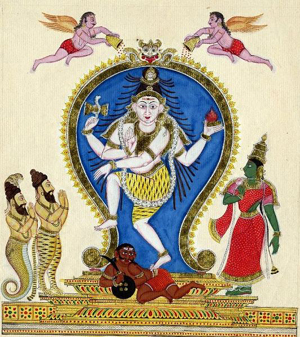
Upamanyu was the son of the sage Vyaghrapada and his story appears in the Mahabharata. He had acquired a taste for milk, but none was available in the forest hermitage where he lived. He asked his mother for some, but she was unable to give him any. She explained that they were living simply and primitively and that they depended on Siva for all their needs. Seeing in this statement a chance to take his request to a higher authority, the boy demanded to know who Siva was and asked how he could earn His grace. His mother taught him how to mediate, without being aware that her son was only learning in order to beg for milk.
When the boy had mastered the technique of meditating on Siva, Siva appeared before him and said, ‘Child Upamanyu, I am pleased with you. You are a sage already. You are a great devotee. I have seen that you are a brahmarishi in the making. You will have eternal youth and lustre. An ocean of milk will be there for you whenever you want it. You can enjoy this with all your friends and relatives and finally you will have bliss by attaining Me.’
A local tradition locates this incident at Chidambaram. The Tirupparkadal Tank – ‘The Tank of Divine Milk’ – is situated to the north of the main temple compound. Adjoining it is a math that is supposed to be the place where Manikkavachagar, the ninth-century Saiva poet-saint, recited his Tiruvachakam poems when Siva visited him and enquired about them. Siva wrote them all down and left them where they could be discovered by the priests of the temple.
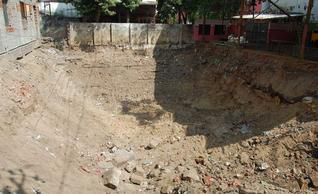
The Dikshitars took Guru Namasivaya to his appointed spot near the Tirupparkadal Tank and returned to the temple.
Guru Namasivaya sat there, absorbed in the Self, until the pangs of hunger again brought him back to the world. In his usual fashion he called out to Parvati for food:
My lady Sivakami whom the wise
well versed in literary Tamil
praise with honeyed words.
I offer praises to Your golden feet
that tread the realms of heaven,
that You may preserve from starvation
this flesh-bound bodily frame.
I beg You, bring me rice!
At the conclusion of the song, the Mother brought him food. As She was approaching him, She sang a verse in reply:
I, Sivakami, sister to the great Lord
who in ancient times drank with relish
milk at the demoness’ breast, have brought rice to delight
the servant and slave of Guhai Namasivaya.
The ‘great Lord’ in the first line is Krishna, the avatar of Vishnu. In Tamil Nadu Sivakami is regarded as being Vishnu’s younger sister. When Krishna was a baby, a demoness called Putana was engaged to assassinate him. She went to his house in disguise, with poison in her breast, and tried to breast-feed him. Krishna sucked the life out of her, along with the milk, and she died after assuming her original form.
From that day on Lady Sivakami daily brought food and gave it to Guru Namasivaya. He continued to sit there, absorbed in his yogic practices.
While he was staying in that spot, many people who frequented the place used to leave money in front of him because, after seeing him, they felt that he was a very great spiritual being.
After some time, when a large amount of money had piled up in this way, Guru Namasivaya looked at it and commented, ‘This wealth is a killer of man’.
He told the people who were nearby at the time to take it all for themselves. This they did. When the three thousand priests saw what was happening, they were upset because they felt that a lot of wealth was being wasted. They went to Guru Namasivaya and begged him to change the place where he sat and did his yoga.
‘Because you are staying here, outside the temple, all kinds of people are taking away the money that is being given to you. If you come inside the temple and let us collect the money for you, a lot of holy works and endowments can take place, So, please come and sit inside the temple.’
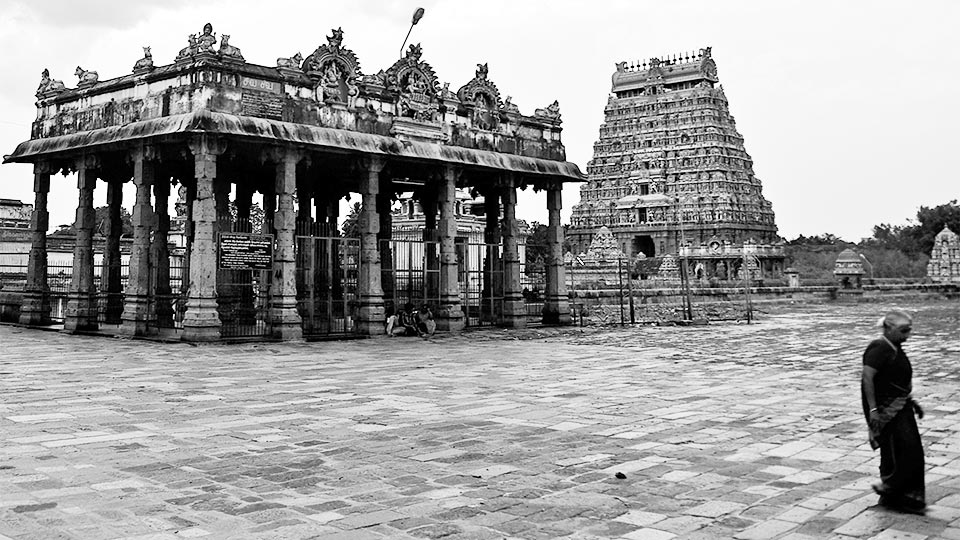
‘I have come here at the request of the Lord of Chidambaram,’ replied Guru Namasivaya. ‘What reason is there for me to go inside?’
The three thousand priests felt that Guru Namasivaya would never come inside if they alone invited him. Instead, they asked the three principal priests to intercede directly with the deity.
They went to Him and said, ‘If Guru Namasivaya comes inside the temple, money will come and many holy works and endowments can start.’
‘Yes, this is good,’ said the Lord. ‘But he won’t come if you call him. I myself will go and fetch him.’